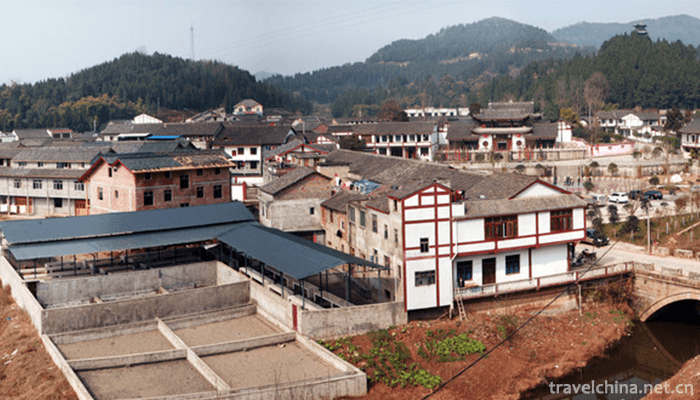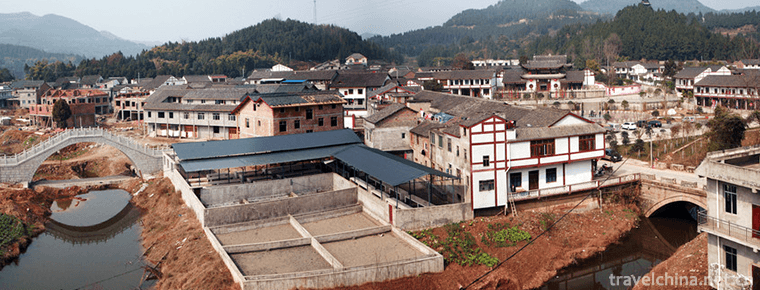Langzhong Tiangong Courtyard Fengshui Cultural Scenic Area
Langzhong Tiangong Courtyard Fengshui Cultural Scenic Area
Tiangongyuan Fengshui Cultural Scenic Area is located in Tiangong Township, southwest of Langzhong City, 29 kilometers away from the urban area, covering an area of more than 10 square kilometers. The scenic spot has a long history and abundant tourism resources. Its forest coverage rate is over 52%, and the climate is warm and pleasant. Tiangongyuan, the core scenic spot, was also listed as a provincial cultural relics protection unit in 2002, and its Tiangong village was listed as a provincial historical and cultural village in 2005. It is also a national AAAA scenic spot. It is the only Chinese traditional geomantic omen theory as the theme of cultural tourism scenic spots.
Historical culture
Founded in Tang Dynasty, it will be rebuilt in three years tomorrow. Because of the profound astronomical culture in Langzhong, astronomers Yuan Tianquan and Li Chunfeng of the Tang Dynasty settled down in their late years. They chose the place to observe the sky, wrote books and said that they were buried there after their death. The Tiangong Court was built in memory of them.
geographical environment
The Fengshui Cultural Scenic Area of Langzhong Tiangong Court is located in Tiangong Township, Langzhong City, Sichuan Province.
The scenic spot has a long history, rich tourism resources, forest coverage of more than 52%, and a pleasant climate. The scenic spot consists of Tiangong Court Ancient Architecture Complex, Tang Dynasty astronomer, Taoist geomancy master Yuan Tiangu Tomb and Li Chunfeng Tomb, Tiangong Ancient Town, Xihe Ancient Street, Xihe Tourist Area, Jiuqu Taijishui and other scenic spots. Among them, Tiangong Court, the core scenic spot, was listed as a provincial cultural relic protection unit in 2002, and Tiangong Village, where it is located, was listed as a provincial historical and cultural village in 2005.
Main attractions
Tianhou Palace Scenic Spot
Temple of heaven
Founded in the Tang Dynasty, it was abandoned in the dynasty. The existing building was rebuilt in the third year of Ming Ying Zong Tianshun (1459 A.D.) and is a provincial cultural relics protection unit. It was built in memory of the astronomers and algebraists of the Tang Dynasty, Yuan Tianquan and Li Chunfeng, masters of geomantic omen of Taoism. Legend has it that this courtyard is the best place for both Yuan and Li to "insert bronze money with gold needles". It has been used as a folk astronomical number research and pilgrimage place, as well as a folk Taoist and Buddhist courtyard. Tiangong Courtyard is built on a turtle-back-like "Shengbaogang" stone terrace, which is a holy place with the pattern of "holding the sacred in Kowloon" in geomantic omen.
Compass square
Compass Square is composed of Tianchi, Longfeng Rotating Chair, 13 layers of information of heaven, earth and human, and sixty-four hexagrams and drums around it. It can be called "the world's largest compass". When people enter the compass square, they will be brought into the mysterious and mysterious geomantic world and feel the extraordinary wisdom of the geomantic sages.
Chunfeng Tomb Scenic Spot
Li Chunfeng Tomb, located in Wulongtai Mountain, 3 kilometers south of Tiangong Courtyard, covers an area of 2300 square meters. The tomb is a circular hill with a top of 20 meters. The pattern of "two dragons holding pearls" is formed by the arch support echoed by the Paomaling and Huilong Mountains.
Puebei Garden is located at the foot of Li Chunfeng's tomb. On the scenic wall shaped by dragons and phoenixes, it shows the amazing prophecy books of Yuan Tiangu and Li Chunfeng, masters of Tang Fengshui.
Push Back Map. There are 60 elephants in the book, in order of 60 Jiazi. Each elephant is equipped with "pictures", "hexagrams", "prophecies" and "eulogies". It predicts the prosperity and disorder of later generations. The comments of Jin Shengtan, a scholar in the late Ming and early Qing Dynasties, are also attached. Entering the pushback garden is like entering a mysterious maze of knowledge; appreciating the pushback pictures is interesting and enjoyable.
Tiangu Tomb Scenic Spot
Yuan Tiangu's tomb is located on the hillside of Guanjia Mountain, one kilometer away from Tiangong Court, situated in the north and south, covering an area of 1,600 square meters. It is the place where Yuan Tiangu, the master of Fengshui in Tang Dynasty, chose to return. The tomb is built on the hill, facing the palace of heaven, which corresponds to Li Chunfeng's tomb. The Ming Tang in front of the tomb is vast, with Longshan on both sides. The two rivers of Dengjia River and Fengming River converge into the Xihe River. The geomancy of the two rivers follows the pattern of "Kirin running to the sun".
Tourist guide
Tickets: $40
Opening hours: 8:30-17:30 (October 8-April 30), 8:30-18:00 (May 1-October 7)
Development road
In Tiangong Township of Langzhong City, Nanchong, Tiangong Village, with its strong cultural background and emerging agricultural industry, has become a well-known rural tourist attraction in Northeast Sichuan. Today, Sichuan News Network reporters learned that a team of the village's Party branch skillfully took advantage of external forces, tapped potential, and strengthened their strength, and went out of a practical way to enrich the people and revitalize the village.
Tiangongyuan Village in Langzhong City has a provincial cultural relic protection unit, Tiangongyuan ancient building complex, Yuan Tiangong cemetery and Li Chunfeng cemetery. In addition, the village still has relatively intact Ming and Qing Dynasty residential Mujia ancient courtyard, ancient Han tombs, Longshanyi site, Hanchong Guoxian site and other high-value historical and cultural sites.
Scenic spot honor
Provincial cultural relics protection units; National AAAA-level scenic spots; China's only traditional geomantic omen theory as the theme of cultural tourism scenic spots.


-
1.Wanpingkou Scenic Area
Wanpingkou scenic spot is located in Rizhao, a beautiful coastal city in Shandong Province. "Tourist sunshine is bound to Wanpingkou" has become the consensus of tourists around the world
Time 2018-12-17 -
2.Yabuli Ski Resort
Yabuli Skiing Resort is a national AAAA-level scenic spot, located 20 kilometers southeast of Yabuli Town, Shangzhi City, Harbin City, Heilongjiang Province, 240 kilometers away from Harbin City
Time 2018-12-22 -
3.Huashan pictographs
Huashan rock paintings are located in the Zuojiang River and its tributary Mingjiang River valley of Chongzuo City, Guangxi (covering Ningming County, Longzhou County, Jiangzhou District and Fusui Cou
Time 2019-01-17 -
4.Mudan River Side Wall
The Mudanjiang Side Wall was built in the Tang Dynasty, presumably at the junction of Mudanjiang City in Heilongjiang Province and the northeast of Hailin County.
Time 2019-02-07 -
5.The Legend of the Cloth Bag Monk
From the end of Tang Dynasty to the Five Dynasties, the monk of Fenghua, Ningbo City, Zhejiang Province, named Tingzi, was an eminent monk of Hou Liang in the Five Dynasties
Time 2019-04-04 -
6.Shaoxing opera
Shao Opera, a traditional Chinese opera. Originally known as "Shaoxing Chaotian Bomb", commonly known as "Shaoxing Daban", it originated from Qin Opera and was named Shaoxing Opera
Time 2019-06-14 -
7.Tongrentang Traditional Chinese Medicine Culture
Tongrentang Traditional Chinese Medicine Culture, one of the traditional Chinese medicine, is declared by Beijing Tongrentang (Group) Co., Ltd., one of the national intangible cultural heritage.
Time 2019-06-21 -
8.Turkish Wheel Autumn
There is a beautiful and magical legend about the origin of Tu's wheel autumn. Legend has it that in order to find a way out of life, the ancestors of the Tu nationality ploughed their fields successi
Time 2019-06-23 -
9.Maogus Dance of Tujia Nationality in Western Hunan
Maogus Dance of Tujia Nationality in Western Hunan Province, the traditional dance of Tujia and Miao Autonomous Prefecture in Western Hunan Province, is one of the national intangible cultural heritag
Time 2019-07-06 -
10.Firing Techniques of Yaozhou Kiln Ceramics
Yaozhou kiln is a treasure of Chinese traditional ceramic technology. It was created in the Tang Dynasty and matured in the Five Dynasties. It reached its peak in the Song Dynasty and declined gradual
Time 2019-07-11 -
11.Zhaojue Temple
Zhaojue temple, located 5 kilometers north of Chengdu, is known as "the first Zen forest in Western Sichuan". It was changed into a Buddhist temple in the Tang Dynasty (627-649) and named Jianyuan temple.
Time 2020-10-18 -
12.Neijiang social security
In 2019, there were 109600 people participating in the endowment insurance (including retirees) of government institutions, 842500 people of enterprise employees (including retirees), and 1501700 people of urban and rural residents. 52100 new urban jobs
Time 2020-12-16